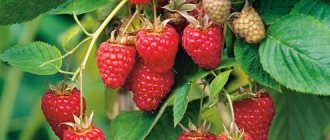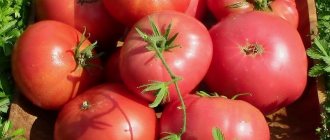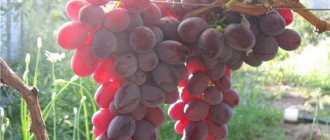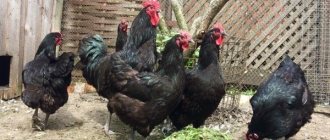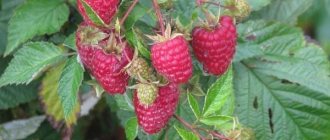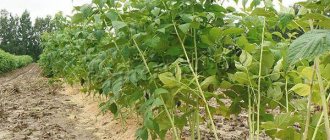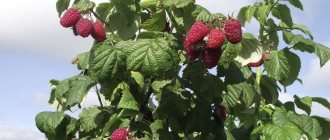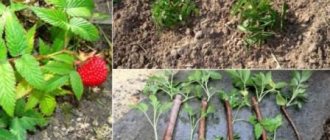Raspberry Ruby giant is a new remontant variety that produces crops not only in summer, but also in autumn. The first harvest of berries can be harvested in the year of planting. By the name you can guess the color and size of the berries.
AGRO PREMIUM is an innovative, environmentally friendly plant activator, without chemicals, that protects berries, fruits and vegetables from pests and diseases, increases seed germination, stimulates root formation and plant growth, and significantly increases productivity.
Raspberries have excellent varietal characteristics, are undemanding to care, and produce abundant harvests. The Ruby Giant variety is perfect for growing by beginning gardeners.
Its most striking feature is its resistance to low air temperatures. This makes it possible to grow bushes even in cold areas. The ruby giant is valued not only for the size of its berries, but also for its high yield.
What are remontant raspberries?
Knowledge of the main features of the remontant variety and its differences from other varieties of raspberries will help you grow healthy plants and harvest a bountiful harvest of berries. Such crops do not have a long lifespan; they produce new shoots every year.
The berries ripen on these shoots. In winter, the bushes freeze, so they need to be trimmed as close to the ground as possible.
Such varieties bring harvest several times a season or continuously. Plants require proper care due to their increased need for water and nutrients.
Remontant raspberries have a lot of positive qualities:
- Due to late flowering, it manages to avoid damage from diseases and pests inherent in this crop.
- The fruits do not contain toxins and chemicals, since raspberries do not need to be treated with toxic substances.
- Fresh berries are present in the diet for 2-3 months.
- Increased resistance to frost is associated with complete pruning of the bushes, when only the roots remain from the bushes. They tolerate winter well.
- The yield of remontant varieties is much higher than ordinary ones.
- The berries are characterized by increased keeping quality.
The disadvantages of remontant raspberries include taste. They are not as high as a regular one. Due to the constant fruiting, the plants have to be constantly and abundantly fed and watered.
Reviews from gardeners about the “Moscow Giant” raspberries
The Gigant Moscow raspberry variety began to be cultivated in household plots and garden plots not so long ago. Most reviews from amateurs and professionals are positive . All of them note the good adaptive qualities of the seedlings, ease of care and excellent productivity. Farmers also had a high opinion of the taste of the berries.
- Good sugar content and attractive appearance are complemented by excellent transportability and keeping quality.
- But many farmers also noted the variety’s resistance to diseases and pests , as well as to changing climatic conditions. The Moscow Giant tolerates winter and frost well, even without shelter.
- However, there was a fly in the ointment. A subshrub of this species has a high ability to grow greenery , which negatively affects its yield and the size of the berries. To avoid this, experienced practitioners advise not to overdo it with fertilizing.
Raspberries of the Moscow Giant variety are well transportable.
Most gardeners recognized the variety as one of the most promising for further cultivation.
History of the development of the Ruby Giant variety
The Ruby Giant raspberry owes its appearance to the work of Moscow breeding scientists from the All-Russian Breeding and Technological Institute of Horticulture and Nursery Growing.
The goal of the work was to create a variety with high frost resistance, resistance to transportation and various diseases. Thanks to these properties, the plant can be grown in all regions of our country.
More on the topic: Harvest raspberries of the Tatyana variety
The Patricia variety was used as the mother variety. The originator of the Ruby Giant is V.V. Kichin.
Features and Specifications
This type of berry is a novelty in gardening; it is a variety of Patricia raspberries, taking all the best from it. The description of the Ruby Giant raspberry variety below will allow you to verify this:
- spreading bushes reach a height of 1.8 m and have a distinctive feature - they are thornless;
- raspberries live up to their name - they truly have a gigantic fruit, reaching a weight of 11 g;
- The giant is quite productive - in one go you can take about 2 kg from a bush, and over the entire season - up to 8-9 kg;
- ripening occurs in July, and the fruiting period extends to 3 months;
- the shape of the berry resembles a truncated cone, colored ruby pink;
- The aroma of the fruit is truly raspberry, but the tasting qualities are inferior to some varieties; but this does not prevent you from making delicious jams from the berries.
Ruby giant
The duration of fruiting of giant raspberries is due to the fact that the berries on the shoots ripen unevenly and ripen slowly. In addition to the described features of the bush, the advantages of this variety should also be highlighted.
Advantages of the giant raspberry:
- unpretentious to growing conditions;
- the density of the berries makes them transportable;
- Giant is a frost-resistant variety (tolerates well down to -30 degrees);
- Another important characteristic is immunity to most infectious diseases.
It is possible to increase the large-fruited variety if you provide proper care for the plants.
Description of the variety
The Ruby Giant bush can reach a height of 1.5 m. This height is considered average for raspberries. New shoots are formed in small quantities, from 8 to 9 pieces.
At the end of fruiting, the old stems die off and must be eliminated. The branches do not have thorns, which greatly simplifies harvesting and caring for the bushes.
Up to 25 berries can form on one shoot.
The leaves are colored in light green shades and are quite large in size. They have characteristic ribbing. Their tips are pointed.
The weight of the fruit can reach from 12 to 14 g. It should be noted that this size can only be achieved with careful care of the plant and compliance with a full range of agrotechnical measures.
With average care, the weight of the berries will not exceed 8 g. In shape, they resemble an elongated cone of dark burgundy color. They are slightly pubescent, have a dense structure and do not contain seeds. They have a sweet taste with faint sour notes, are aromatic and very tasty.
Ruby giant belongs to the category of large-fruited varieties of universal use. Raspberries can be eaten fresh, frozen for the winter, or made into jam, preserves, tinctures, juice or compote.
Due to their dense structure, the fruits tolerate transportation well. Raspberries are often grown commercially.
Plants with mid-ripening berries
They are characterized by abundant fruiting and resistance to unfavorable conditions and diseases. The berries are large. Sweet, aromatic.
Atlant
Having learned about the new variety, everyone was chasing Atlant raspberries . How reasonable are gardeners' expectations? Let's try to consider the characteristics of the variety.
Reviews from amateur gardeners
Caramel remontant mid-season
A young remontant variety, bred by breeders in 2013 . Half-meter stems grow vertically, the bush is erect. Dense shoots, so the variety does not need tying.
Reviews from gardeners
Orange miracle
Compact, medium-sized plant with shoot heights up to 1.8 m . The erect stems are completely covered with thorns. When growing, it is recommended to install a trellis, since under the weight of the berries the shoots bend to the ground and can break.
Penguin
A variety of domestic selection, bred in 2006. Suitable for amateur gardening, less commonly grown for industrial purposes.
What do gardeners say?
Polana
A high-yielding and early-fruiting variety of Polish selection, it was released in 1991. The berry crop has perfectly adapted to our climate, so it can be grown everywhere.
Tarusa
Summer raspberries with powerful, erect stems. People call it the raspberry tree, as it is a standard plant. The variety appeared in 1987.
Useful properties and rules for using chestnut honey, contraindications, ways to identify a fake
Reviews from gardeners
Monomakh's hat
Reviews about the variety
Advantages and disadvantages of the Ruby Giant variety
The Ruby Giant raspberry has numerous positive qualities. These include:
- later flowering period compared to other varieties. This allows you to avoid most diseases;
- Toxins are not concentrated in the berries due to the refusal to use toxic chemicals;
- long fruiting period, allowing harvesting throughout the summer;
- plant resistance to adverse weather conditions;
- high degree of keeping quality and resistance to transportation.
Minor disadvantages include the weak acidity of the berries and the need for increased watering and fertilization. Nevertheless, these shortcomings may not be noticed against the backdrop of the numerous advantages of the variety.
Brief description (pros, cons)
Advantages of the variety
- flowering begins later than conventional varieties, which saves the crop from return frosts even in areas of unsustainable agriculture, as well as some pests;
- disease resistance reduces chemical treatment;
- harvest duration is 3 months, which allows you to enjoy vitamin products almost throughout the entire summer season;
- excellent yield and large-sized fruits;
- resistance to frost and unpretentiousness to the composition of the soil.
The negative side of the variety is the more sour taste of the berries compared to traditional varieties. The disadvantages include more careful care of remontant varieties, which requires time and physical effort.
Growing rules
Remontant raspberry varieties are planted in the same way as regular ones. The best time to plant Ruby Giant is from September to October. This depends on the climatic conditions of the region.
If you plant the plant in time, it will have time to adapt to the cold before winter sets in. The harvest can be harvested in the spring. Spring sowing is also acceptable. It is carried out into heated soil before the process of sap movement in the plants begins.
For normal growth and development, the Ruby Giant needs a place protected from the wind with plenty of warmth and light. It can be planted next to houses, fences and outbuildings, but on the sunny side. When the plant is shaded, there will be a sharp decrease in yield.
The soil should be loose, loamy and retain moisture well. Before planting, you must add:
- humus,
- peat,
- wood ash,
- superphosphate,
- potassium sulfate.
The soil acidity level should be weak or neutral.
The planting process consists of the following steps:
- you need to dig up the soil, prepare holes or trenches for planting;
- rows are made at a distance of 1.5-2 m from each other;
- the gaps between bushes should be at least 1-1.5 m. This is due to the spreading nature and height of the variety;
- before planting seedlings, you need to straighten the roots and cover the plants with soil to the level of the root bud;
- compact the soil and water the plants at the rate of 5-10 liters per bush.
Landing
Bryansk ruby is planted in mid-spring or autumn. When planting before winter, it is necessary to take into account that the bushes need time to take root, so planting is done a month and a half before the first frost.
Raspberries of the presented variety prefer sunny areas, protected from gusty winds. Soil acidity also matters. Severely acidified soil must be limed for at least two years before planting raspberries.
It is undesirable to plant Bryansk ruby raspberries:
- in low-lying areas with stagnant water;
- along buildings, blind fences;
- next to tall fruit trees.
In the shade, Bryansk ruby grows poorly, and the berries become small and sour.
Before planting, you need to prepare the site. Both trenches (0.5 m wide, 0.4 m deep) and individual holes are suitable.
Young plants need a large amount of organic matter and complex mineral fertilizers. For 1 m2 of planting you will need up to 10 kg. rotted manure or compost, 50 g of potassium salt (only in spring), 450 g of ash, 90 g of granulated superphosphate. After laying down the nutrients, wait 1-1.5 months, then begin planting. In order to retain moisture, the bushes are covered with a layer of mulch.
Rules for caring for Ruby Giant raspberries
This variety requires minimal care due to its unpretentiousness. For high yields, it is recommended to carry out the following agrotechnical measures:
Watering
The frequency and rate are determined in accordance with the climatic situation. With regular precipitation, additional moisture is not required.
More on the topic: Remontant raspberries of the Izobilnaya variety
You need to ensure that the water moistens the soil to a depth of 40 cm. It is better to water the plants with warm water and make sure that it does not get on the stem and leaves.
Loosening
This increases air circulation and access to the root system. The depth of loosening should not exceed 8 cm. This action is repeated 4-5 times during the summer period;
Mulching
It is used to ensure that the roots of the plant do not overheat in the sun, do not dry out and are protected from the cold. You can use hay, sawdust, humus, straw and compost as a protective layer and change it annually. The protective layer is usually made 5 cm thick;
Tying up
If the bushes are not tied to supports, they will lie on the ground and the berries will spoil. In addition, when tied, each plant receives more air and sunlight;
Trimming
Before the onset of winter, remove weak plants and those that have finished bearing fruit. In spring, dry and frozen shoots are removed;
Varieties for the south of Russia
A characteristic feature of this region is early and hot spring. Therefore, it is better to plant bushes in the fall; spring plantings do not have time to take root before the high summer temperatures and die, despite constant watering.
- "Glen Fine" Medium ripening with an extended fruiting period, resistant to drought. The berries have a pleasant taste and a long shelf life. The plant is not difficult to grow and always produces a high yield.
- "Glen Ample." Received the highest rating for heat resistance. The fruits are very sweet and aromatic, average weight is 4-5 grams, but there are giants up to 10.
- "Joan G." Remontant variety of medium ripening period. There are no thorns. The berry is sweet without sourness, fleshy, dark red in color.
- "The Pride of Russia." Early ripening, large-fruited type with high yield.
Southern raspberry variety - Glen Ample
Late ripening raspberries
In order for the aromatic berry to delight you with its fruiting all season long, be sure to buy late-ripening varieties. These include:
- "Mirage". The fruits are large, dense, sweet, and do not fall off for a long time.
- "Brigantine". The berries are tasty, dark crimson in color, with slight pubescence. Productivity is about 2 kg per bush. Winter hardiness is high.
- "Dense." The variety is winter-hardy with good yield and transportability. The berries are raspberry in color and have a sweet and sour taste.
- "Stolichnaya". The plant is devoid of thorns. The berries are bright red, elongated, large (up to 8 grams), do not fall off after full ripeness for 3-4 days.
- "Taganka". The berries are juicy, aromatic, weighing up to 5 grams. Productivity per bush is 5 kg. Requires shelter for the winter.
Taganka must be covered for the winter
Ruby Giant Pest Control
Despite its high resistance to diseases and pests, the variety requires preventive measures due to neighboring plants that can become carriers of diseases.
Before the first flowers appear, the bushes are treated with insecticidal preparations. When spider mites appear, sulfur-based substances are used. You can also use folk remedies - infusion of onion or garlic peels.
To combat the raspberry beetle, you need to dig up the soil and treat the plants with the necessary substances. Also, before flowering begins, you need to treat the bushes against aphids.
The Ruby Giant raspberry can not only become a decoration for any plot, but also please its owner with its undemandingness to growing conditions and high yield.
Despite the fact that the variety appeared quite recently, it enjoys deserved popularity among many gardeners. It can be used both for industrial purposes and for personal use.
Care
Large-fruited raspberries will produce a good harvest even with minimal attention, but if you regularly take the recommended measures, the yield will truly be the envy of your neighbors.
First of all, you need to loosen the soil so that the roots have constant access to oxygen. This must be done carefully so as not to damage the young buds. The first time loosening is carried out in early spring, when the plants are still dormant. In general, during the growing season you need to repeat the procedure 5-6 times. It is very important to do this after rain so as to retain natural moisture in the soil.
Nuance! If you are mulching the soil near the sprouts, there is no need to loosen the soil.
Mulching Ruby giant raspberries protects the roots of the plant from deficiency and excess moisture, saves them from drying out, and also protects them during periods of severe frost. If the work is done well, it is enough to apply a layer of mulch once when planting, and then change or update it annually. You can use sawdust, tree bark, straw, compost and even newspapers as mulch. Approximate layer 4-6 cm.
Special attention should be paid to watering. The ruby giant bears fruit for a long time. Therefore, after the first mass harvest of berries, it is necessary to moisten the soil very much so that the ripening fruits have a sufficient amount of moisture.
In general, watering is done as needed. If the weather is very dry and hot, about 5 liters of liquid should be added to each bush once a week. And many gardeners use sprinkling irrigation. To do this, in the evening after sunset, they water the plantings with a hose, and as a result, a lot of dew is formed overnight, which falls from the leaves onto the soil and provides the plants with a sufficient amount of moisture.
It is important to regularly weed and inspect plants for damage by infections and pests. The variety is unpretentious, but the risk of infection cannot be completely eliminated.
Like any other remontant raspberry, the Ruby Giant needs supports. You can install trellises on both sides, forming a tunnel between them, and stretch a thick blizzard of wire in several rows so that branches can be tied to it in the future after the raspberries have shed their leaves. You can cut the branches at the root and leave no more than 2 cm on the surface. Do not spare the plants. Future fruiting and the quality of new shoots depend on this.
Fact! Due to the fact that the stems are completely cut off, the possibility of fungi and pest larvae overwintering on them is excluded.
Pruning should also be carried out in the summer, using pruning shears to remove new young shoots that begin to appear along with flowers and ovaries. Otherwise, they will take away the plant’s strength to grow.
Feeding is carried out 2 times per season. Enough mineral complex fertilizers applied during the active growth of shoots, and then during the formation of the ovary. There is no need to use anything else. An overabundance of nutrients will result in active greens, but will reduce the quality and quantity of the fruit.
Late harvest
Many gardeners are delighted with varieties with late ripening berries. And they have many advantages. Firstly, raspberries ripening in the second half of summer are clean, without pests, and secondly, the ripening time allows you to get fruits when all the plants have practically borne fruit.
Diamond
Large-fruited, but slightly capricious remontant variety . Having planted it on their plot, many gardeners cannot wait until it begins to bear fruit. And when they wait, they are... disappointed. Why is this happening?
Brilliantovaya Growing the Brilliantovaya variety requires certain knowledge of agrotechnical techniques.
For planting, you need to choose an open sunny area, otherwise the yield will be poor. It is better to propagate raspberries in the fall. During planting, the root collar should not be covered with sand.
However, in sandy soil, shallow planting can cause the plant to die . During fruiting, it requires tying to a support. One-dimensional, dark red berries weigh up to 7 g. Harvest in August until frost.
In preparation for winter, cut off the entire above-ground part. Spring pruning is not recommended.
Polka
Opened in 1993 by Polish gardeners. Soon this variety became the standard among other representatives.
Polish She is characterized by:
- good appearance of berries
- high yield
- disease resistance
The medium-sized variety produces many root shoots. The branches do not require additional support, they are dense, and do not bend when fruiting is abundant. There are few thorns, which allows you to harvest without much difficulty.
The berries look like a thimble and have a regular shape. The pulp is dense, red, moderately juicy, not watery. The sweetness of the berries is not cloying, complemented by a slight sourness. It begins to bear fruit at the end of July; harvesting continues until frost.
Thanks to its keeping quality, the variety can be transported over long distances. Suitable for freezing, good for fresh consumption, and for canning.
After defrosting, the berries do not lose their shape and taste.
Taganka
Taganka Juicy, bright red berries have a conical shape, weigh 5 g. Abundant fruiting. One bush produces up to 5 kg of berries; they are easily separated from the stalk.
The tall bush has 7-9 powerful shoots, young ones are covered with soft thorns, and old ones are covered with thorns, which makes harvesting difficult . Dark green, large foliage. The variety is frost-resistant.
Reviews about "Taganka"
For the winter, it is better to cover the plantings with agrofibre. The fruits retain their quality for several days and are suitable for transportation.
However, dry periods lead to reduced yields, so it is necessary to monitor soil moisture so that it does not dry out.
Heritage
Translated from English it means “heritage”. Yes, we inherited an ideal remontant variety. Undemanding to growing conditions, the Heritage variety has gained universal popularity among gardeners.
Heritage Bushes are powerful, compact, low. They form little root shoots. The shoots grow upward, almost vertically.
The berries are located on fruit branches that are quite strong and raised upward.
The fruits weigh 3 g, are medium in appearance, red, aromatic, dome-shaped . The fruits are easily separated from the stalk, but do not fall to the ground on their own. Medium thorniness, long stalks, high self-fertility.
The variety is prone to excessive formation of ovaries, which does not always lead to their full ripening . Therefore, during the 2nd flowering it is necessary to tear off some of the flowers.
Reviews from gardeners
It develops well in open areas and does not like gusty winds, so when planting it is necessary to take this fact into account and provide the variety with a protected place.
The plant is not demanding on soil, but grows better on fertile soils or light loam. When preparing for the winter, all shoots are cut off, even annual growth.
How to plant correctly
Landing dates
Diamond is planted in spring and autumn. With early spring planting, the root system quickly forms, the above-ground part grows rapidly, and within 3 months the harvest ripens. It is planted when the air temperature does not drop to sub-zero levels during the week. However, during spring planting, all the plant’s forces will be directed to survival and development of the root system, so the harvest will be smaller. The best time for rooting seedlings is autumn (late September - early October), when it is still warm enough and raspberries will have time to take root in 20-30 days before the onset of cold weather, and will develop intensively in the spring.
Site selection
The wrong choice of location for a raspberry plant often leads to the death of plants. For Diamond raspberries, it is necessary to allocate sunny areas, preferably on the south side of the garden. Even slight shading negatively affects the quantity and taste of berries. Choose an elevated place. In the spring, the soil in the lowlands takes a long time to thaw, and during prolonged summer rains, water accumulates. At the same time, the roots rot and the plants become susceptible to fungal infections.
To protect the raspberry tree from the wind, it is placed near the fence
The area for the raspberry garden should be well heated by the sun and protected from the wind by a fence, other plantings, and outbuildings. Remontant raspberries grow on any soil, but prefer loose and fertile ones. It does not tolerate an acidic environment, so dolomite and lime are added to the soil. Every 8–10 years, raspberries are replanted so that they do not lose productivity. You can plant it in its original place after 5–7 years.
It is not advisable to plant grapes, sea buckthorn, or parsley next to a raspberry tree - growing these crops together has a bad effect on their growth and productivity. A good neighborhood - cucumbers, onions, carrots, red currants, apple trees, cherries.
Selection of seedlings
Future harvests largely depend on the choice of seedlings. You should not buy them at the markets - you may choose the wrong variety or diseased bushes. They should be purchased only in specialized stores or garden centers, where the plants are controlled and have certificates containing information about the variety. Seedlings should have a well-developed fibrous root system, with many thin roots, without damage or lethargy. Growths or blackening indicate disease. There should be no dark spots or mold on the shoots.
Raspberry seedlings must have developed fibrous roots
Site preparation
The site is prepared 2–3 weeks before planting. Per 1 m² add 2 buckets of humus, 50 g of superphosphate, 30 g of potassium nitrate. It is useful to add ash, which will significantly improve the taste of the berries. After applying the fertilizer, the soil is dug up and loosened. Strongly acidic soil is limed (600 g of lime per 1 sq. m). Holes 60 cm wide and 45 cm deep are dug at intervals of 1 m. It is better to plant raspberries in a trench at a distance of 1 m, 50 cm between rows and 70 cm between bushes. The rows are arranged from north to south for better illumination and warming by the sun. Trenches are dug 50 cm wide and 45 cm deep. When planting, rotted manure is added to the bottom in a 5 cm layer, 200 g of superphosphate, 70 g of potassium salt, 300 g of ash per 1 sq. m. m and mixed with the fertile layer of soil. Before planting, plant roots can be kept for several hours in Kornevin solution or dusted with powder for better rooting and disease prevention.
Step by step process
- The seedling is lowered to the level of the root neck - to a depth of 6–7 cm, and the roots are straightened.
- Cover with soil, leaving no voids, and compact.
- Water - at least 5 liters per bush.
- Shorten shoots to 25–30 cm.
- Mulch the tree trunk circle with dry hay, humus, sawdust, and onion peels in a layer of 10 cm.
